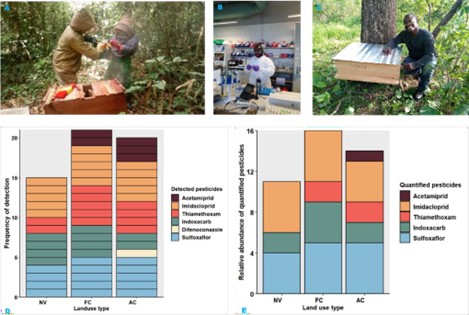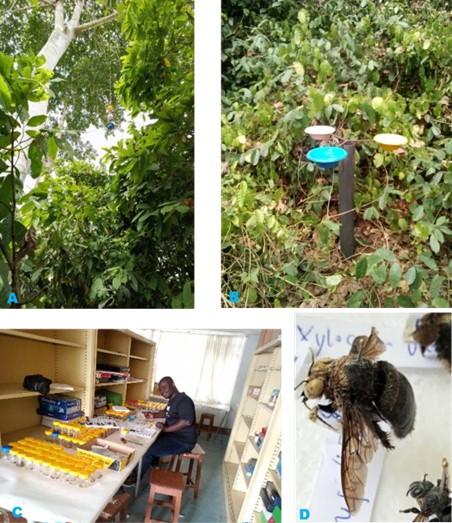Bees and honey production in cocoa growing areas in Ghana: impacts of land use change
Bees and honey production in cocoa growing areas in Ghana: impacts of land use change
Introduction
The project was designed to encompass two distinct yet interrelated research endeavours, each contributing invaluable insights to our overarching objectives. The first research titled 'Exploring pesticide residues in the environment using honey as a proxy,' was designed to perform a comprehensive comparative analysis of Ghana's cocoa and forest landscapes. The primary aim was to ascertain the presence of pesticide residues and evaluate their impacts on bee health and honey quality within these diverse ecosystems. The intricate relationships between pesticide application, land use and the standard of honey in Ghana have undergone careful examination during this study. The subsequent study, 'The impact of land use change on pollinating insects in cocoa and forest landscapes in Ghana,' delved deeply into the transformations occurring within bee and other insect communities and their pivotal role in pollination due to the expanding cocoa cultivation. This multifaceted research spotlighted the intricate interplay between bee populations, land use alterations, and the sustainability of cocoa production, thereby illuminating the complex dynamics among these three critical factors.
Summary of field experiments
The study was conducted within and around Bia Conservation Area in the Bia West District of the Western North Region of Ghana. The Bia West District is one of the leading 71 cocoa producing districts in Ghana. Situated in the district is Bia Conservation Area, a pristine wilderness extending over 306 km2 (encompassing both the Bia National Park covering 77.7 km2 and the adjoining Bia Resource Reserve spanning 227.9 km2). Summarized below the field experiments performed in the landscapes.
Study 1. Exploring Pesticide Residues in the Environment Using Honey as a Proxy
Five honey samples from each of full sun cocoa farms, agroforest cocoa habitats, and the pristine settings of natural forests were carefully collected, marked, and put through a rigorous preservation process, for a total of fifteen samples. Following their careful collection, these samples were taken to Dublin City University in Ireland, where a thorough study of the pesticide residues was conducted. Eight commonly used pesticides for cocoa cultivation— acetamiprid, bifenthrin, difenoconazole, fipronil, imidacloprid, indoxacarb, sulfoxaflor, and thiamethoxam—were explicitly chosen for analysis as part of this study's analytical focus. Exceptional accuracy and strict adherence to accepted procedures were used to conduct this complex analysis. It is noteworthy that six of the targeted pesticides—acetamiprid, difenoconazole, imidacloprid, indoxacarb, sulfoxaflor, and thiamethoxam—were in fact found in the honey samples from different settings. The fact that these pesticide quantities were not beyond the strict Maximum Residue Limits stipulated by the European Union (EU) must be emphasised above all else. This study—the first to be carried out in Ghana's cocoa and forest landscapes—has brought to light the rate of detection of pesticides used in cocoa cultivation in honey.

Fig 1. Pictorial highlights from study 1. A) Honey samples being scooped directly into collection tubes; B) Preparation of sample solution for pesticide residue analysis at Dublin City University; C) One of the beehives mounted inside Bia Conservation Area for sample collection; D) Frequency of detected pesticides and E) Frequency of detected pesticides with quantifiable concentration.
Study 2: The impact of landuse change on pollinating insects in cocoa and forest landscapes in Ghana
A thorough understanding of the ecological dynamics involving pollinating insects within the complex cocoa and forest ecosystems was the goal of the second experiment carried out for this investigation. In order to do this, a total of 18 sites exhibiting a gradient of increasing natural forest cover were carefully chosen. By using both ground-based and airborne pantraps to collect a diverse range of insect communities, the study used a multidimensional strategy. These sample activities were carried out on four different occasions, encompassing the rainy and dry seasons. The gathered insects were rigorously sorted, with bees receiving special attention as they were painstakingly identified down to the species level. Generalised linear mixed models (GLMMs) were used to analyse the obtained data in order to determine how changes in land use patterns affected the abundance of various insect groups. The diversity and number of bees caught at the various sites were also assessed as part of this investigation. This study's examination of the ramifications of its findings for both agricultural and conservation programmes was one of its key features. The study shed light on the crucial role these species play in preserving the delicate balance of these ecosystems by illuminating the complex linkages and roles of these pollinating insects within cocoa and forest environments. The study also looked at the significant effects that changing land use patterns have on pollinator communities, offering insightful information about the complex interactions between human activities and the ecological needs of both agricultural and conservation efforts. After carrying out two rounds of sampling during the dry and wet seasons, we ultimately gathered 20,069.00 individual insects, comprising 15,935 Diptera, 2,430 non-bee Hymenoptera, 723 Coleoptera, 380 Hemiptera, 334 bees, and 267 Lepidoptera. In our investigation, dipterans, which accounted for 79% of the total number of insects gathered, were the most prevalent insect orders. The various insect taxa's responses to changes in the percentage of natural flora varied in terms of abundance.

Fig.2: Pictorial summaries of pollinator experiment. A) An aerial pan trap hosted in the tree canopies; B) Mounted ground pan trap; C) Sorting of collected specimens and dry mounting of collecting bees at University of Cape Coast and D) Xylocopa flavorufa, one of the identified bee species.
Conclusion
The kind funding from the Eva Crane Trust turned out to be the foundation of our study project. It was crucial to the execution of our complex project and had a major influence in its success. The money was wisely used to pay for necessary expenses like buying essential equipment, easing the logistical challenges of our fieldwork, carrying out meticulous laboratory analyses, arranging cross-border field trips and supporting our active participation in prestigious international conferences. We were able to gather important data thanks to it, and conferences helped us effectively share our research with the rest of the world's scientists. The Eva Crane Trust award is evidence of the value of properly focused financial support in increasing scientific understanding and enabling significant advances to our comprehension of the complex ecosystems we investigated. Looking back on the results of our study, it is obvious that this award was a key factor in our success, enabling us to have a significant influence on the fields of entomology, ecology, and environmental science.
Richard G. Boakye,
University College Dublin
Ref.: ECTA_20200901_Boakye

